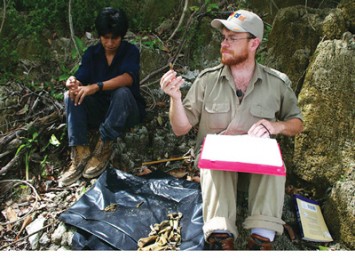Profile: anthropologist Caleb Kestle finds clues in animal bones

Caleb Kestle, a Ph.D. candidate in anthropology, examines ancient animal bones at the shore of Lake Mensabak in southern Mexico.
Caleb Kestle examines ancient animal bones — white-tailed deer, the smaller brocket deer, pig-like peccaries and the guinea pig-like agouti — to discover what it was like 400 to 600 years ago in southern Mexico.
He’s indebted to the archery skills of the Lacandon, a Mayan people who live in the state of Chiapas. Their accuracy accounts for the large number of scattered bones he finds.
Kestle’s research site is the shore of Lake Mensabak, in Selva Lacandona National Park.
The Ph.D. candidate in anthropology has visited four times, staying one to four months each visit.
His dissertation is on “the transition during the Colonial period, 1400 to 1600 A.D., how socioeconomic conditions changed and how it plays out in how the environment is today,” he said.
The larger site is dominated by agouti, “a large rodent, extremely tasty,” he said.
Is he speaking from personal experience?
“Oh yes, I’ve had it,” Kestle said. So has Queen Elizabeth, who was served the delicacy during her visit to nearby Belize in 1985.
“All the sites have large amounts of deer and peccary,” he said. “At a smaller site, agouti is replaced by dog.”
His research “looks at animals in the archeological record to see what the landscapes had to have looked like,” he said.
White-tailed deer inhabited abandoned areas that were weedy and easy to hide in. The smaller brocket deer, generally found only in the tropics, preferred more primary forest.
Some large areas of forest were cut down for agriculture. Primary forest was hardwood, while secondary areas tended to be softwood.
He has found signs of people “walking away” from a region because of violence, disease or forced relocation by the Spanish.
However, “the Spanish missed this lake as far as we can tell,” he said.
A Lacandon myth seeks to explain depopulation. It says the people lived in big cities, where they cast spells to make one another sick. This angered their primary god, Ha’chaku, and he sent disease to destroy the spellcasters. Only those without such knowledge remained.
Lacandons were so respected as archers that logging companies in Chiapas hired them in the early 1800s to provide meat for their workers. They hunted with a variety of arrowheads, ranging from flat tips for small birds to sharp barbed tips for fish.
Kestle was born in Missouri but his father was frequently transferred for his job with the U.S. Department of Agriculture, so the family lived in Washington, D.C., Maryland, Central Illinois and Morocco.
Now a resident of Pilsen, Kestle earned both his bachelor’s and master’s degrees at UIC.
He writes fiction “for fun or when I’m bored,” he said. “It’s something I do when I need to stop working.”
He and a half-dozen other anthropologists make up a birdwatching club.
“Once every two or three weeks we pick a place and walk around with a guidebook,” he said. “We only have one pair of binoculars for the lot of us.”
His habit of collecting animal bones is a hobby as well as a research skill.
“While I was visiting an uncle in Florida I found a wild pig dead on the side of the road,” he said. “I put it in a trash bag, then I boiled it and used borax to get the grease off the bones.”
Kestle still regrets leaving behind a dead porcupine he found in Michigan’s Upper Peninsula.
“My old lady [his girlfriend at the time] was already upset about the pig,” he explained.
“I decided not to test my luck.”
